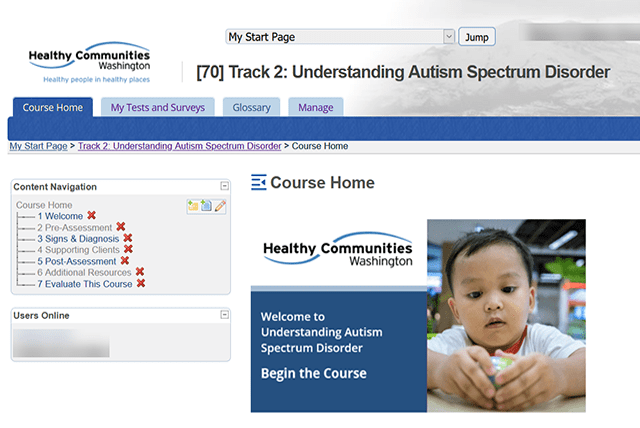One of the most talked-about subjects regarding post-pandemic work is the possibility of flexible — or hybrid — learning models. But what exactly does this mean and how does it apply to professional development?
Training is a big-budget item every year. Decisions about what your team needs to learn and where they should learn are important. Those decisions can impact how much time they spend away from their day-to-day duties and how much time they can dedicate to upskilling. New training technologies, techniques, and learning systems can help you train your employees more efficiently and cost-effectively. It pays to embrace a flexible mindset about the best ways you can reach your training goals, whether that’s through remote online training, in-person workshops, or a hybrid learning approach.
Put simply, hybrid learning means that your staff has the flexibility to take the best of in-person and remote approaches and merge them to make programs run smoothly.
This blog includes an overview of the top learning formats — in-person, online, and hybrid —, how to best go about them, and what you can expect from each.
Before Deciding on A Format, Conduct A Needs Assessment
Performing a training needs assessment of your workforce is an important first step in creating an online training initiative. It’s essential for creating the kinds of professional development opportunities that will improve the knowledge, competence, and effectiveness of your staff.
Before you do anything to train your staff, find out what your stakeholders need from a program and what your employees need to learn. This will help you create a program that has a greater chance of success.
An Overview of the Most Popular Learning Formats
With needs in hand, you can turn your focus to the best format for your professional development program.
There are several types to choose from, including:
- Self-Paced learning
- Instructor-Led learning
- Classroom learning
- Hybrid learning
Let’s have a look at each one.
Self-Paced Learning
For many agencies, remote, or virtual training, is the clear answer. It’s a useful, cost-effective way to give your staff new skills or refresh ones they already have. Plus, it’s safer than sitting in a conference room with dozens of other people during a pandemic.
More specifically, most of Talance’s clients are seeking a self-paced (or self-guided) format. This lets participants learn when they want to within an overall timeframe. Self-paced or self-guided courses differ from a live meeting, such as a Zoom meeting, because a learner is given a window of time within which to complete the course. Instead, a session conducted over a virtual meeting requires that everyone be online at the same time.
The top benefit of this format is that learners get to learn when they want. Self-paced programs are very flexible and fit with their schedule because they have access to the content around the clock. It also tends to be far less expensive than classroom training.
Instructor-led Learning
As with self-paced learning, instructor-led training (ILT) is an online course is one where most or all of the curriculum is presented online. It’s very fast, and it’s often less expensive than other options.
The main difference is the instruction. An ILT course requires that an instructor or facilitator be present to help. They may grade tests, read assignments, participate in forums, answer questions or do other activities to interact directly with learners.
The ILT format is very helpful for people who need a little more additional assistance than self-paced professional development programs. But the downside is it requires a stricter schedule and the employment of a facilitator.
In-person Learning
On-site classroom training is the old-school way to do it. It requires that everyone be in the same place at the same time to learn. Most organizations do this through workshops, seminars, on-the-job peer training, or other face-to-face methods.
In-person training can be effective and it’s often required for some jobs. Expect to pay more for this kind of staff learning, however. In addition to course development, you may have to pay for trainers to come to your location or pay for your staff to go to another location.
Hybrid Learning
Hybrid learning, sometimes called blended learning, merges traditional face-to-face methods with online learning. This is a common method of training that addresses many of the shortcomings of a purely online or a purely in-person strategy.
In a hybrid professional development program, workers would complete online courses or parts of online courses. Then, they would meet up in person for demonstrations or workshops that work best in a live format.
Take the example of the Office of Healthy Communities (OHC) at the Washington Department of Health. The Office of Healthy Communities combined the best elements of in-person and online training to implement a blended learning model for their statewide community health worker training program (read more in the case study). OHC allows its network of facilitators around Washington to supplement a brief live session with an in-depth online course that contains assessments, assignment tools, and collaboration.
The hybrid training model is efficient, lean, and scalable. This allows it to meet funding variables and limitations. It also makes training fast and easy, which can be difficult in Washington. It’s a large state with rural pockets not easily accessible for traditional in-person learning programs.
“E-learning allows us to reach remote areas of the state to teach community health workers. Staff only need to stay one day in each location so it lowers costs of delivering the training significantly,” says Debbie Spink, instructor and community health worker training system coordinator. “We need the support of the online curriculum. It would be cost-prohibitive to offer this training only in person.”
How To Use Hybrid Learning In Professional Development Programs
Is a hybrid learning approach right for your organization? Here are five secrets of what it takes to build a winning program.
Set educational goals
Saving money and expanding training capacity might be the overall goals of moving to a blended model. But you should set educational goals that fit the new strategy.
Include Trainers from the Start
A hybrid learning strategy does not mean your training staff will be out of a job, but they might not realize that. Remember to include your training staff from the beginning and remind them that the technology is a complement to their work in a face-to-face setting. Work with them to identify ways to use technology as a tool rather than a job replacement.
Support Your Learners’ Needs
Not all learners learn the same way: Some are better visual learners, some do fine with self-paced study, and others may have different language skills.
When you start planning for a blended professional development program, minimally start by looking at what your workers and your organization need.
Likely, your organization will have more factors you’ll need to assess. Doing a needs assessment will allow you to match your findings with a learning technology or other solution, that matches your learner population.
Get Your Employees Excited About Hybrid Learning
Change is a frightening word in some organizations, and not always welcome. But if you want your professional development investment to pay off and help your staff retain knowledge and new skills, you’ll need to do some cheerleading.
Head off any pushback against hybrid learning from trainers, participants, and administrative staff by focusing on excitement and motivation from the very beginning.
In general terms, this means ensuring your staff knows why they’re taking hybrid training and that the value is clear. It also means giving them educational materials that are designed for adult learners. Grown-ups need to juggle competing demands, preferred learning styles, and their own familiarity with the delivery method.
Be ready with a list of benefits and get buy-in early. Listening and being open is often the best way to address concerns. Here are some more tips on motivating distance learners.
Adapt and Evaluate
A hybrid learning model is new for many organizations’ professional development plans, and new systems can be a challenge to implement.
Many administrators view evaluation as time-consuming and costly, but they shouldn’t. In fact, by ignoring how well (or poorly) your training program is engaging participants and making a difference in their work, you could be wasting time and money. Try these resources to get buy-in from hybrid learning skeptics.
As you roll out your hybrid learning program, frequently evaluate it so you can quickly identify problems and address them.
The Best Training Is the Right Training
The most important takeaway when choosing a method for training your team is to find the right one that works for them. The best training—the kind that people remember and can use on the job right away—is the kind they relate to. It should be engaging, not intimidating, and empowering so that when they have their new skills, they’re ready to go.
At Talance, we work with health organizations to develop custom training that fits their teams’ unique needs. If you’re ready to explore online learning or have questions, book a consultation with one of our experts.



